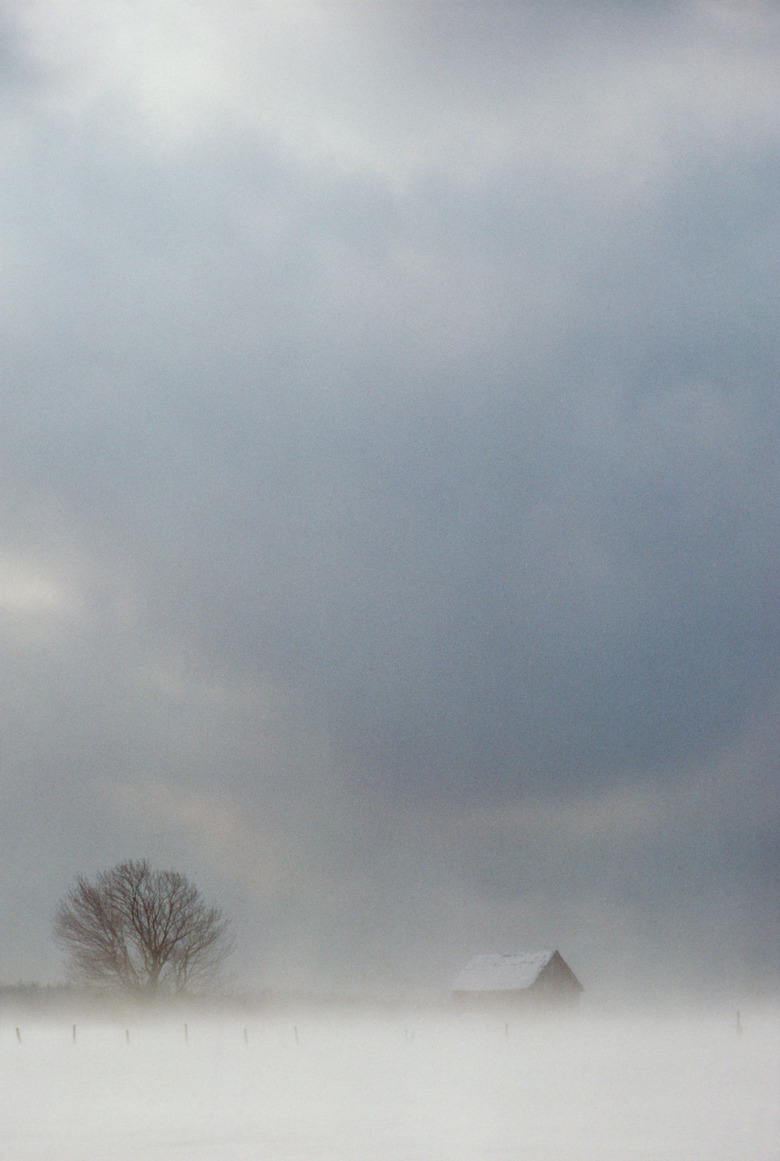How Is A Blizzard Storm Formed?
Blizzards form when low-pressure weather systems combine with geographical features to bring cold northern air into contact with warm and humid southern air. The weather systems have the low pressure at the center. Cold air from the north and warm air from the south rush in toward the low pressure. As the low-pressure systems develop, the cold and warm air start circulating in a counterclockwise fashion around the low-pressure center. At this point a geographical feature such as mountains help channel the cold and warm air to meet and cause the blizzard.
TL;DR (Too Long; Didn't Read)
Intense snow storms called blizzards form when cold, northern Canadian or Coloradan air meets warm, humid southern air while swirling around a low-pressure weather system. The Canadian air is especially cold because the great plains at the center of Canada don't hold heat very well. The sun, during the northern winter, shines only during the short days and at a low angle, producing little warming. When a low-pressure system develops, the northern cold air and southern humid air rotate around the low-pressure center of the weather system and the Rocky Mountains channel the two air masses together. The cold air is forced under the lighter warm air, which in turn cools and releases its moisture. The moisture drops through the cold air mass, freezing and falling as snow. The effects of the low pressure and the mountains result in high winds that blow the snow and create the blizzard conditions.
The Three Causes of Blizzards
The Three Causes of Blizzards
Blizzards in the United States are caused by three characteristics of the landscape. Blizzards require especially cold air, the formation of low-pressure systems and the effect of mountains or similar obstacles to help produce the winds. When the three causes are present at the same time and in the same area, blizzard formation is likely.
Cold northern air for blizzards comes from the Canadian prairies. This flat, open region across western Canada doesn't hold heat very well. It is completely snow-covered in winter and gets very little sun during the short winter days. The sunlight that reaches the prairies is at a steep angle due to the northern latitude and it has little heating effect.
Across the United States central plains, weather systems with low-pressure centers form continuously. Strong low-pressure areas from Colorado or from Alberta can both bring cold and warm air masses together and form intense storms.
For an intense storm to become a blizzard with the corresponding strong winds and heavy snow, a geographical feature to channel the winds is required. To the west of the United States Great Plains, the Rocky Mountains take over this role. The cold air from Canada can't escape to the west but is forced to flow south along the mountains. The effects of these three factors include the strong winds and heavy snow of a blizzard.
Blizzard Formation
Blizzard Formation
The effects of a blizzard can include road closures, snow days off for schools and businesses, and dangerous conditions for any kind of travel. Meteorologists therefore look out for blizzard formation to give warnings to the areas likely to be affected.
Blizzards start out as normal storms with a low-pressure area forming near Colorado or in the north, in Alberta. As the weather system strengthens, its low pressure sucks in cold air from the north and warm air from the south. The cold and warm air masses start circulating around the low pressure area in a counterclockwise direction but are obstructed by the Rocky Mountains to the west.
Because of the obstruction, both the low pressure and the winds intensify and the storm becomes stronger. The cold air is forced under the warm air, which is lighter due to its higher temperature. As it rises, the warm air cools and releases its moisture. The moisture freezes as snow, ice pellets or freezing rain when it falls through the cold air mass. As the precipitation reaches the ground, it is carried at high speed by the strong winds of the blizzard. Snow storms can occur anywhere in the world with cold air, but the really intense storms called blizzards can only form when all three causes are present.
Cite This Article
MLA
Markgraf, Bert. "How Is A Blizzard Storm Formed?" sciencing.com, https://www.sciencing.com/blizzard-storm-formed-22022/. 30 July 2018.
APA
Markgraf, Bert. (2018, July 30). How Is A Blizzard Storm Formed?. sciencing.com. Retrieved from https://www.sciencing.com/blizzard-storm-formed-22022/
Chicago
Markgraf, Bert. How Is A Blizzard Storm Formed? last modified March 24, 2022. https://www.sciencing.com/blizzard-storm-formed-22022/
